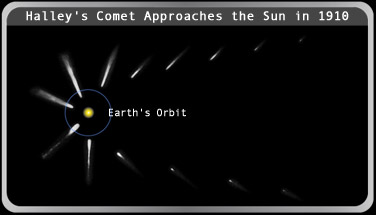 |
|||
|
Part 2 Part 1 |
|||
|
Tale of the tails
The Sun is very active, even explosive, and it's always sending out hot gases along with all its light. It also has a magnetic field. So the space around the Sun is not empty! The hot gas and magnetic field bulge outward, and they are called the solar wind. As the Sun's light and the solar wind stream outward, they push on the atmospheres of planets, and also comets. Both the light and the solar wind are forms of energy from the Sun. The solar wind sweeps some of the dust and gases coming off the comet outward, forming two, or even several long tails behind the comet. You may remember from the History section that the word “comet” comes from the Greek name for “hairy star.” Use your imagination, and you can see how these long, bright tails can look like hair streaming from a star.
The dust grains reflect the Sunlight, making the tail look very bright. This trail of comet dust keeps moving along the comet's path behind the nucleus. A comet's dust tail can be ten of millions of kilometers (10,000,000 km) long. It is amazing to think that such a huge tail (nearly 1000 times the earth's diameter) comes from a nucleus only a few kilometers across. To give you an idea of how amazing this is, our marble-sized comet would have a tail around 50 miles long!! ? A Comet can lose hundreds, or even thousands of kilograms of material each second as it passes by the Sun and forms a dust tail. Does this mean that comets could eventually disappear? What do you think, and why? This Tail is a Gas The smaller tail, called a plasma tail, is often very hard to see without a telescope. Plasma is another word for very hot, glowing gas. The plasma tail is made up the gases from the coma. Like the coma, the plasma tail glows with its own light. It too is heated by the energy from the Sun and it turns this energy into a pale, often bluish light.
|
|||
| You and comets have become quite familiar. Now click Continue to see how comets get close to the Sun. | |||
|
|
|||

 Both of the comet tails are pushed away by the light and solar wind that is always streaming out of the Sun. This means the tails always point away from the Sun. The dust tail may curve a bit, but the plasma tail points directly away, so that the two tails may seem to form a "V". Sometimes the tails even point ahead of the comet instead of trailing behind!
Both of the comet tails are pushed away by the light and solar wind that is always streaming out of the Sun. This means the tails always point away from the Sun. The dust tail may curve a bit, but the plasma tail points directly away, so that the two tails may seem to form a "V". Sometimes the tails even point ahead of the comet instead of trailing behind!